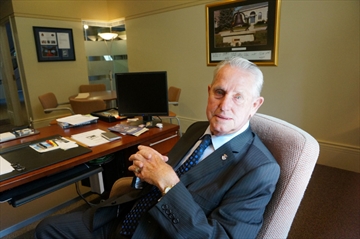Repost from DeSmogBlog
Purposeful Distraction? Unpacking the Oil Refiners’ “Bomb Trains” Lawsuit vs. Warren Buffett’s BNSF
By Steve Horn, Tue, 2015-03-24 15:58
On March 13, American Fuel & Petrochemical Manufacturers (AFPM) — the oil refiners’ trade association — sued oil-by-rail carrying giant Burlington Northern Santa Fe (BNSF) for allegedly violating its common carrier obligation under federal law. A DeSmogBlog investigation has revealed there may be more to the lawsuit than initially meets the eye.
Filed in the U.S. District Court for the Southern District of Texas, Houston Division, AFPM sued BNSF “for violating its common carrier obligation by imposing a financial penalty” for those carrying oil obtained via hydraulic fracturing (“fracking”) in North Dakota’s Bakken Shale basin and other hazardous petroleum products in explosion-prone DOT-111 rail cars.
AFPM‘s beef centers around the fact that BNSF began imposing a $1,000 surcharge for companies carrying explosive Bakken fracked oil in DOT-111 cars, as opposed to “safer” CPC-1232 cars, at the beginning of 2015.
The Warren Buffett-owned BNSF did so, argues AFPM, illegally and without the authority of the federal government.
“This $1,000 surcharge on certain PHMSA-authorized rail cars breaches BNSF’s common carrier duty to ship hazardous materials under the auspices of PHMSA’s comprehensive regime governing hazardous materials transportation,” wrote AFPM‘s legal team, featuring a crew of Hogan Lovells attorneys. “Allowing railroads to penalize companies that ship crude oil in federally-authorized rail cars would circumvent PHMSA’s statutory and regulatory process for setting rail car standards for hazardous materials shipments.”
Upon a quick glance, it seems like a fairly straight-forward case of federal law and an intriguing example of an intra-industry dispute. But as recent history has proven, the devil is in the details.
BNSF Surcharge Not Unique
Though unmentioned in AFPM‘s lawsuit, BNSF is not the only oil-by-rail “bomb trains” company promulgating a surcharge.
In February 2014, eight months before BNSF announced its surcharge, Canadian Pacific Railway Ltd. (CP Rail) and Canadian National Railway Company both announced their own DOT-111 surcharge intentions.
“CP Rail will add a $325 ‘general service tank car safety surcharge’ on each car of crude that is shipped in any container other than the CPC 1232 model, effective March 14, it said in a notice issued to customers,” Reuters reported. “The new tiered pricing scheme comes the same week that Canadian National Railway Co also confirmed it was increasing rates for the older variety of DOT-111 tank cars.”
In its lawsuit, AFPM disapprovingly cited minutes from a March 19 meeting held between BNSF higher-ups and U.S. Pipeline and Hazardous Materials Safety Administration (PHMSA) higher-ups in which a BNSF told PHMSA that “there needs to be [a] disincentive to use DOT 111.”
Those minutes were included as an exhibit to the complaint.
Yet in the Reuters article, CP Rail spokesman Ed Greenberg stated that his company had the same goal as BNSF: to “encourage shippers to work towards an upgraded tank car standard for crude by rail shipments.”
AFPM Lobbies vs. Regs, Funds Denial
As first reported here on DeSmogBlog, AFPM has attended meetings with the Obama White House’s Office of Information and Regulatory Affairs (OIRA), which serves as an industry-friendly mediator between industry and executive-level regulatory agencies like PHMSA. BNSF top-level lobbyists, executives and attorneys have also had a seat at the table at those myriad meetings.
PHMSA is expected to publish a final version of updated oil-by-rail regulations in May, after announcing a delay in January. AFPM also submitted comments in opposition to PHMSA‘s draft rules in September 2014, arguing it’s an issue of train tracks and people, not the rail cars themselves.
“While AFPM supports appropriate and effective mitigation, several of PHMSA’s proposed measures fail to take meaningful steps toward preventing derailments, risk significantly reducing crude rail capacity, and cost billions of dollars,” wrote AFPM. “AFPM respectfully submits that any effort to enhance rail safety must begin with addressing the primary root causes of derailments and other accidents: (1) track integrity and (2) human factors.”
Beyond advocating against oil-by-rail regulations, AFPM also funded a May 2014 study concluding that Bakken crude oil is no more chemically volatile than any other oil.
“Bakken crude oil was found to be well within the limits for what is acceptable for transportation as a flammable liquid,” the report concludes. “This survey shows that Bakken crude oil does not pose risks that are significantly different than other crude oils and other flammable liquids authorized for transportation as flammable liquids.”
BNSF Responds — Sort Of
Five days after AFPM filed its lawsuit, BNSF responded in the form of a press release. Well, kind of.
“BNSF continues to review the complaint…challenging [its] recent implementation of rate discounts for crude shippers that load their product in rail cars with improved safety characteristics,” stated the company.
“This rate structure is also consistent with BNSF‘s ongoing efforts to ensure the safe transport of crude on our network, including voluntary adoption of enhanced operating practices around crude oil shipments and requesting the federal government to make newer, safer tank cars the new standard for crude-by-rail shipments, replacing the older DOT-111 and non-modified CPC-1232 cars.”
Purposeful Distraction?
So, what gives? Why a lawsuit against BNSF by AFPM and not against CN Rail nor CP Rail? No clear answers exist and AFPM did not respond to a request for comment sent by DeSmogBlog.
Despite the murkiness at play, some answers do exist.
Firstly, CPC-1232 tanks cars — the centerpiece of the lawsuit — have proven no “safer” than DOT-111 tank cars to begin with. And secondly, the lobbying and advocacy track records of both BNSF and AFPM demonstrate they both prefer the status quo over robust regulations, which would hurt their corporate bottom lines.
Purposeful or not then, at the end of the day, the lawsuit still serves as a distraction for the central issues in the oil-by-rail debate as the May deadline nears for PHMSA to publish its final regulations.
Image Credit: Cartoonresource | Shutterstock

